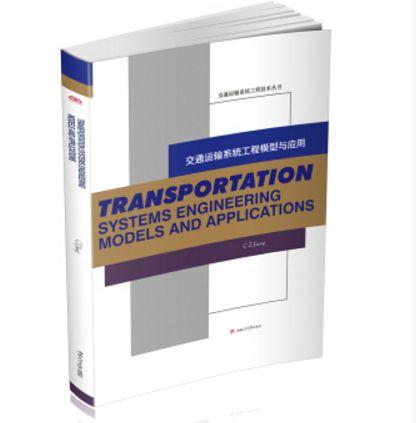《交通運輸系統工程模型與套用》是2016年11月1日西南交通大學出版社出版的圖書,作者是蔣朝哲。

交通運輸系統工程模型與套用
相關詞條
- 交通運輸系統工程模型與套用
《交通運輸系統工程模型與套用》是2016年11月1日西南交通大學出版社出版的圖書,作者是蔣朝哲。內容簡介《交通運輸系統工程模型與套用》首先重新定義了交通系統,針對交通運輸供給系統進行分析,特別是基於運輸成本和交通流量的關...
- 運輸系統工程
系統工程在運輸系統的規劃、設計、管理和調度等方面的套用。這裡運輸系統是指由鐵路運輸系統、公路運輸系統、內河和遠洋運輸系統、航空運輸系統、管道運輸系統與城市運輸系統有機組成的綜合運輸系統。科技名詞定義 中文名稱: yunshu xitong ...
- 交通規劃模型及其套用
《交通規劃模型及其套用》是一本於1999年1月中國鐵道出版社出版的圖書。內容介紹 內 容 簡 介 作者在從事交通運輸領域科研與教學工作的基礎上,詳細論述了整個交通規劃的基本原理、模型及其套用。內容包括運輸問題與建模概述、四階段交通...
- 道路交通運輸系統工程
道路交通運輸系統工程是系統工程在道路交通運輸領域中具體套用的分支學科。它以道路交通運輸系統的整個運輸活動為對象,將人、車、路、運輸基礎設施、信息作為一個有機整體,從系統的觀點出發,以數學和工程等科學的方法為工具,綜合運用汽車...
- 交通運輸系統工程(2014年中南大學出版社出版的圖書)
《交通運輸系統工程》是2014年中南大學出版社出版的圖書,作者是鄧紅星。內容簡介 本書全面闡述了系統與系統工程的基本概念、 理論和方法。分章節詳細介紹了交通運輸系統的概念與特點、 交通運輸系統工程的含義及內容、 交通運輸系統分析、 ...
- 交通運輸系統工程(第2版)(2015年2月國防工業出版社出版的書籍)_百度...
《交通運輸系統工程(第2版)》是2015年2月國防工業出版社出版的圖書,作者是郭瑞軍。內容簡介 本書共分為11章,比較全面地闡述了系統與系統工程的基本理論、交通運輸系統、系統分析、系統模型與仿真、運輸系統預測、運輸系統網路最佳化、...
- 交通運輸系統工程(2018年西安交通大學出版社出版的圖書)
《交通運輸系統工程》是2018年10月西安交通大學出版社出版的圖書,作者是彭其淵、蔣朝哲、文超、魯工圓。內容簡介 本書介紹了交通運輸系統工程的方法和套用,主要內容包括交通運輸系統分析,交通運輸系統模型,交通運輸系統預測,交通運輸系統...
- 交通運輸系統工程(2008年國防工業出版社出版的圖書)
《交通運輸系統工程》是2008年國防工業出版社出版的圖書,作者是郭瑞軍。本書比較全面地闡述了系統與系統工程的基本理論、交通運輸系統、運輸系統分析、運輸系統模型與仿真、運輸系統預測、運輸系統網路最佳化、運輸系統綜合評價、運輸系統決策及...
- 公路工程設計信息模型套用標準
《公路工程設計信息模型套用標準》是中華人民共和國交通運輸部制定的標準作為公路工程行業推薦性標準,自2021年6月1日起施行。《公路工程設計信息模型套用標準》的管理權和解釋權歸交通運輸部,日常管理和解釋工作由主編單位中國交通建設股份...
- 交通運輸系統工程(第2版)(2017年東南大學出版社出版的圖書)
全書共分10章,主要內容包括:運輸系統工程概論、運輸系統分析、運輸系統模型、運輸系統預測、運輸系統網路計畫技術、運輸系統模擬、運輸系統評價、運輸系統決策、運輸決策支持系統、智慧型運輸系統等。《交通運輸系統工程(第2版)》可作為高等...
- 交通運輸系統工程(第三版)
全書共分為九章,各章末均附有“思考與練習題”,便於讀者對本章節內容的理解、消化和套用。 本書可作為交通運輸類、物流管理類本、專科院校“交通運輸系統工程”、“系統工程”或“物流系統工程”課程的教材或教學參考書,也可供...
- 公路工程施工信息模型套用標準
《公路工程施工信息模型套用標準》是中華人民共和國交通運輸部制定的標準,作為公路工程行業推薦性標準,自2021年6月1日起施行。《公路工程施工信息模型套用標準》的管理權和解釋權歸交通運輸部,日常管理和解釋工作由主編單位中國交通建設...
- 交通系統工程
按照交通系統研究過程及思路的整體性,全書分九章,包括交通系統工程、交通系統分析、交通系統模型、交通系統預測、交通系統最佳化、交通網路技術、交通排隊理論、交通系統評價和交通系統決策,覆蓋了交通系統中系統工程的套用範圍。《交通系統工程...
- 交通工程學(道路工程學科中派生出的學科)
與交通工程密切相關的主要學科有:汽車工程、運輸工程、人類工程、道路工程、交通規劃學、環境工程、自動控制、套用數學、電子計算機等。因此,交通工程學是一門由多種學科相互滲透的新興邊緣學科,交通工程學與其他學科的關係如下圖所示。主...
- 交通運輸工程
道路與鐵道工程 道路與鐵道工程是交通運輸工程的二級學科,主要開展路面結構合理性和材料性能研究、公路工程病害分析與防治、路基與路面新材料開發與套用、公路工程環保和景觀設計、公路工程施工工藝等方面的研究。研究內容既可以是交通運輸工程...
- 公路工程信息模型套用統一標準
《公路工程信息模型套用統一標準》是2021年人民交通出版社出版的圖書。根據《交通運輸部關於下達2017年度公路工程行業標準制修訂項目計畫的通知》(交公路函[2017]387號)的要求,由中國交通建設股份有限公司和中交*公路勘察設計研究院有限...
- 公路工程設計信息模型套用標準(JTG/T 2421—2021)
《公路工程設計信息模型套用標準(JTG/T 2421—2021)》是2021年人民交通出版社出版的圖書,作者是中國交通建設股份有限公司。內容簡介 根據交通運輸部《關於下達2017 年度公路工程行業標準制修訂項目計畫的通知》(交公路函〔2017〕387 號) ...
- 基於元胞自動機的交通系統建模與模擬
《基於元胞自動機的交通系統建模與模擬》是2007年科學出版社出版的圖書,作者是賈斌、高自友。本書主要介紹了元胞自動機模型在交通系統建模與模擬中的套用等知識。內容提要 本書在理論研究方面不僅可以對解決當前我國城市交通問題提供一定的...
- 交通運輸系統工程(2020年人民交通出版社出版的圖書)
交通運輸系統工程 《交通運輸系統工程》是2020年人民交通出版社出版的圖書,作者是衛學啟。
- 公路交通運輸系統工程
作者是邱榮祖。內容提要:本書比較全面地闡述了系統與系統工程的基本理論、交通運輸系統、運輸系統分析、運輸系統模型與仿真、運輸系統預測、運輸系統網路最佳化、運輸系統綜合評價、運輸系統決策及對策,以及運輸系統工程套用案例等內容 ...
- 系統工程學及套用
3.4 切克蘭德軟系統方法論59 3.5 並行工程方法60 3.6 物理事理人理系統方法 (簡稱WSR)63 3.7 螺旋式推進系統方法65 3.8 系統工程方法論最新發展66 3.9方法論的套用案例67 複習與思考72 第4章 系統模型及建模方法73 ...
- 交通運輸系統工程(2018年北京大學醫學出版社出版的圖書)
交通運輸系統工程 《交通運輸系統工程》是2018年北京大學醫學出版社出版的圖書。
- 智慧型交通系統工程導論
本書書名定為《智慧型交通系統工程導論》,是把智慧型交通系統與系統工程的方法論結合起來,使讀者能正確地套用系統工程的理論、方法去分析、處理問題並進行工程實踐。系統工程是包括多門工程技術的一大門類,也是高度綜合的實用性很強的工程技術...
- 交通運輸工具原理及運用
第7章 交通運輸工具運用管理信息化 7.1概念、作用及基本功能 7.1.1信息 7.1.2信息化 7.2管理信息化的工作流程 7.2.1管理信息化的內容 7.2.2管理信息化的工作流程 7.3套用 7.3.1途途鐵路運輸管理信息系統 7.3.2途途...
- 交通運輸安全系統工程
《交通運輸安全系統工程》是2014年12月中南大學出版社出版的圖書。內容簡介 交通運輸安全系統工程是以現代系統理論為基礎, 以安全管理理論為指導, 套用系統工程的原理和方法, 從基本理論、 安全分析和評價、 安全管理和事故防範等角度...
- 交通工程學原理與套用
該書可作為交通運輸類專業的必修課教材,也可供交通規劃、設計、運營管理、投資等單位及工程技術人員參考,同時也適合剛接觸交通工程專業的從業人員和成人自學使用。圖書目錄 前輔文 第一章 交通工程學介紹 1.1 交通及其系統認識 1.1....
- 運輸與物流系統仿真
《運輸與物流系統仿真》是2009年同濟大學出版社出版的圖書,作者是徐瑞華。本書講述了系統仿真模型基礎及隨機數的產生方法等知識。內容簡介 近年來,系統仿真在交通運輸與物流領域得到了廣泛的套用。系統仿真涉及系統工程、建模理論、計算機...
- 運輸系統規劃與設計
3.5交通分配階段 108 3.5.1概念和定義 108 3.5.2非均衡交通分配模型 110 3.5.3均衡交通分配模型 110 3.5.4交通分配模型套用舉例 112 第4 章道路網路系統規劃與設計 117 4.1概述 117 4.1.1城市道路功能與特點 117 4.1....
